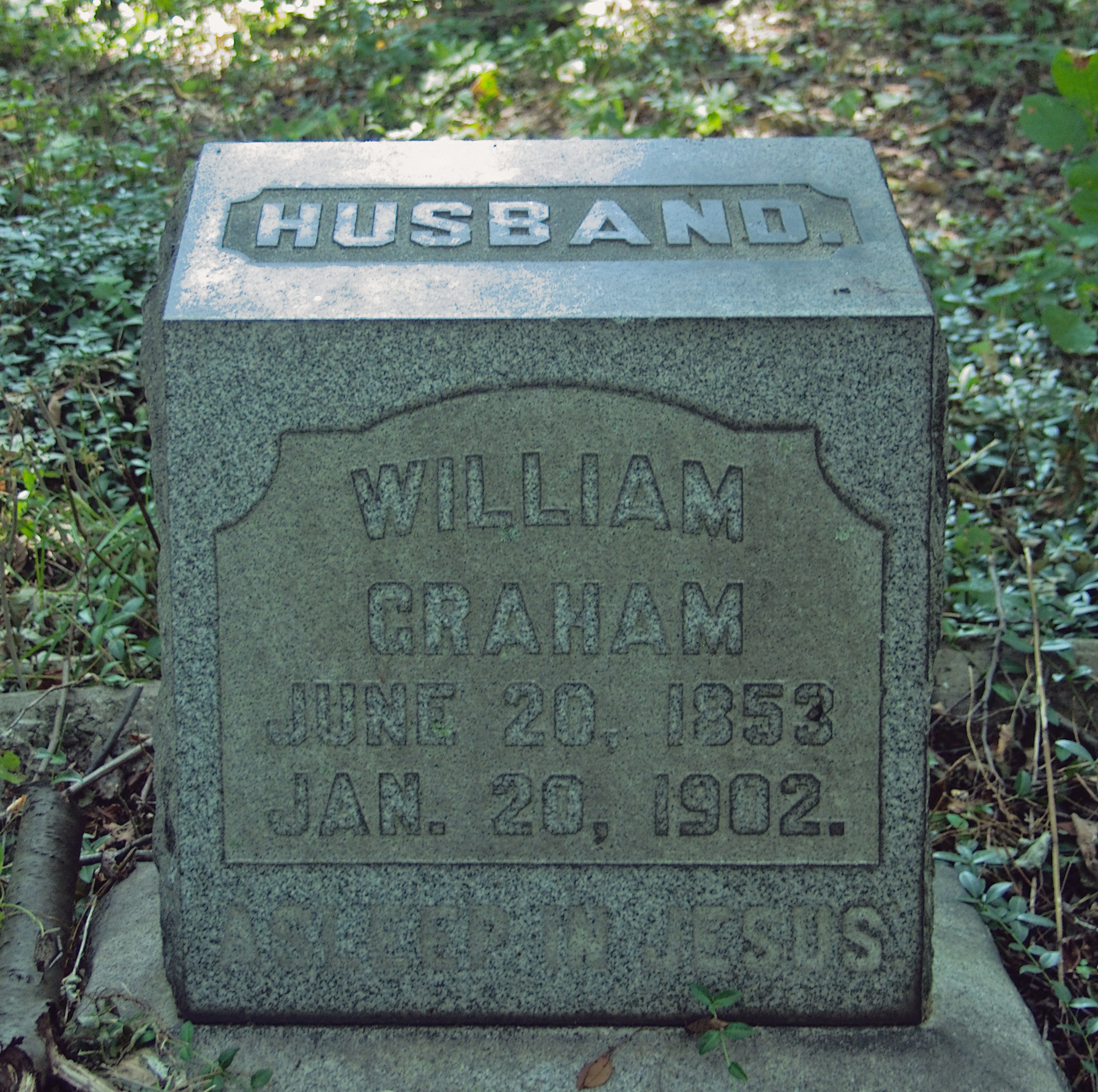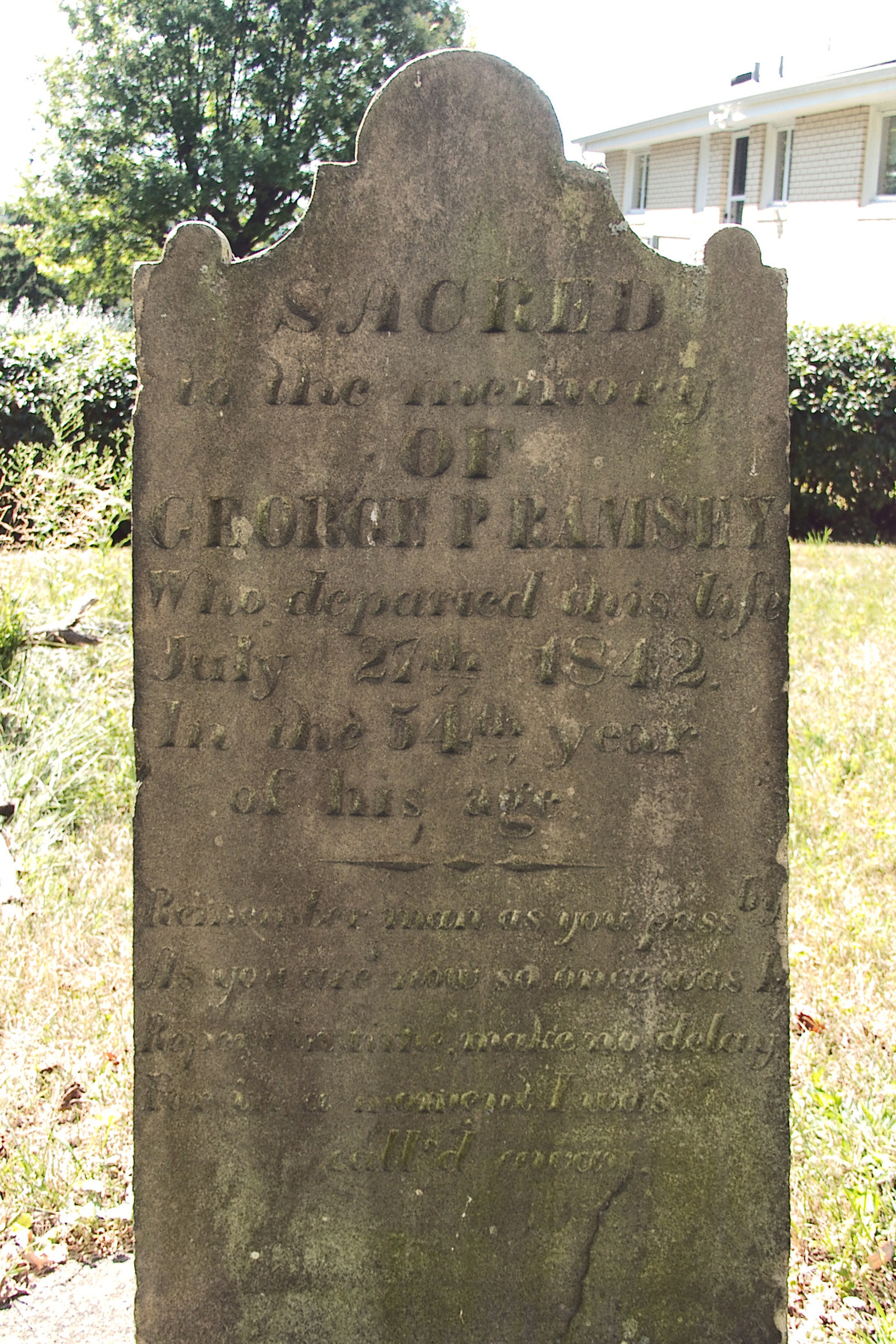From the dates Father Pit guesses that these are two brothers, both of whom died in their twenties six years apart. Clearly the same stonecutter did the exceptionally neat lettering on both stones: all-capitals tombstones are unusual in the 1830s, and note the graceful curve of the bottom stroke in the letter E, the reduced size of the line “WHO DEPARTED THIS LIFE,” and the straight underline under the “TH” in ordinal numbers. We shall call this artist the Master of the Bethany Capitals.
-
-
Crecencia Lutz Monument, St. Mary’s Cemetery, Ross Township
This towering monument is in a style all its own. What shall we call it? Pittsburgh German Rococo? The inscription, cut by a local stonecutter (a tradition that survived among the Germans here decades longer than it did among English-speakers) quotes from Job: in the words of the King James Version, “Seeing his days are determined, the number of his months are with thee, thou hast appointed his bounds that he cannot pass.“ The German translation of the first line would be more closely rendered as “Short are the days of man,” which is a more striking sentiment that seems tailor-made for an epitaph.
The relief is a bit elementary, like something that would have been turned out by the second-best student in a community-college sculpture class. The overall composition, however, is unforgettable. The blackness of industry has only added to the impression that this monument is something colossal and important.
-
C. H. and W. H. Tombstone, Mount Pisgah Cemetery
A priceless piece of folk art, this memorial to two children who died in the late 1800s was carefully carved by a barely literate family member or friend who makes the letter N backwards. The carver could not carve delicately enough to spell out the names, so we get only initials, which doubtless were enough for the family as long as memory endured.
Old Pa Pitt calls this “priceless” not necessarily because of the skill involved—it is not an especially skillful work—but because it documents how ordinary people of the late 1800s imagined a tombstone should look. It is clearly an imitation of the tombstones of fifty years or more before, complete with a little tree laboriously scratched into the stone for each of the two deceased.
Father Pitt is having a little trouble working out the dates. The obvious way of reading the stone is to divide it in left and right halves:
C. H.
BORN AUGUST
26 • DIED
OCT • 6
1881W. H.
BORN
FEB • 19
DIED•FEB
1
1891You can see the difficulty: this reading has W. H. dying before he was born. Perhaps the stonecutter has recorded only the birthdays and omitted the years of birth, in which case we do not know for certain even that these were children.
The picture was taken when the stone was strongly backlit. Father Pitt has boosted the local contrast and used various other manipulations to make the inscription more legible.
You might have trouble finding this stone if you went looking for it. It is well into the overgrown woods section of the Mount Pisgah Cemetery, and Father Pitt actually used his foot to hold back a hickory seedling in order to get an unobstructed picture.
-
Mount Pisgah Cemetery
This is the churchyard of the Mount Pisgah Presbyterian Church in Green Tree. The little cemetery itself straddles the line between Green Tree and the Westwood neighborhood of Pittsburgh, and it is a curious fact that the section of the cemetery in Green Tree is neatly maintained, but the section in Pittsburgh is overgrown and forgotten—although some attempt had been made to clear some of the larger bushes from it when Father Pitt visited. Doubtless the true explanation of the phenomenon is that the overgrown section is not visible from the church, and thus can be allowed to go to ruin without making a spectacle of itself every Sunday.
Tombstones litter the forest in the overgrown section. Much of the ground cover is Vinca minor, which is often called Cemetery Vine because it was such a popular planting in old cemeteries.
In this section were some old family plots fenced with iron rails; we can still identify the Graham family plot, below:
Note, again, the luxuriant growth of Vinca minor.
There are tombstones here that go back to the 1840s at least, but most of the older ones are illegible, if they can be found at all. Here, however, is a legible tombstone from 1842 (forgive the strong backlighting):
SACRED
to the memory
OF
GEORGE P. RAMSEY
Who departed this life
July 27th 1842.
In the 54th year of his age.
—
Remember man as you pass by
As you are now so once was I;
Repent in time, make no delay,
For in a moment I was call’d away.The epitaph begins as one well-known funerary poem and ends as another; the last line has five feet instead of four. But it is still a powerful sentiment.
In spite of the general neglect, someone cares enough to see that all the identifiable veterans have flags for their graves, so that little flashes of red, white, and blue light up the floor of the woods. Here is the grave of Corporal David Aston, a Civil War soldier whose birth and death dates are not mentioned:
-
Rebecca Ritchey Tombstone, Hiland Cemetery
REBECCA RITCHEY
departed this life,
December 27, 1838.
Aged 42 years 11 months
& 4 days.Here is a work by a stonecutter whom we shall call the Master of the Italic Months, from one of the most distinctive features of his style. He also writes the name of the deceased in all capitals (not small capitals), and he places a comma after the words “departed this life.” He adds an ornamental dash below the inscription. His lettering is not nearly as neat as that of the Master of the Erratic Centering, who also cut many stones in the Hiland Cemetery; but, on the other hand, his centering is a bit better.
















